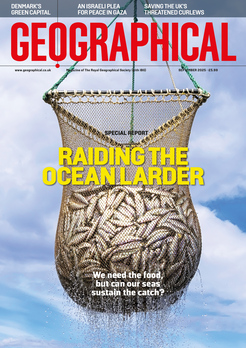
In her new book, Nomad Century, award-winning science writer Gaia Vince explores how we can prepare for mass migration in the coming years, as a result of climate change and rising temperatures
Book of the month
Review by Shafik Meghji
Heat and humidity have rendered equatorial regions across the Americas, Africa and Asia uninhabitable for much of the year. Polynesia has vanished beneath the sea, dry rivers and aquifers have forced people to abandon eastern China and many of the glaciers that fed major rivers in India, Pakistan and beyond have been lost. The Sahara stretches into central Europe, western Antarctica is ice free, the oceans have vast dead zones and the Amazon is a desert. Compact, high-rise cities have sprung up across Greenland, Scandinavia and Siberia. Patagonia, Tasmania and New Zealand are similarly densely populated with residents from across the globe.
In the opening chapters of Nomad Century, science writer and broadcaster Gaia Vince paints a stark picture of what the world is likely to look like if global average temperatures rise 4°C above pre-industrial levels. This isn’t a distant or unrealistic prospect: climate models suggest we’re currently heading towards a 3°C–4°C rise by the end of the century – less than three generations away. Even if we succeed in limiting global heating to below this level, our lives will still be utterly transformed over the coming decades: ‘Human movement on a scale never seen before will dominate this century and remake our world.’
In this rigorously researched, accessibly written and illuminating book, Vince – who, in 2015, became the first woman to win the Royal Society Science Book of the Year Prize solo for her debut, Adventures in the Anthropocene – examines what these changes will entail and how we should respond. While not shying away from the scale of the challenges, she doesn’t give in to fatalism or inertia: ‘[We] are facing a species emergency –
but we can manage it.’ Despite widespread recognition of the seriousness of the climate emergency, Vince argues that there’s an elephant in the room: ‘For large portions of the world, local conditions are becoming too extreme and there is no way to adapt… Large populations will need to migrate, and not simply to the nearest city, but also across continents.’
Vince explores how we can prepare for and manage the mass migration of billions of people, a process that’s already well underway. In 2020, for example, the yearly total for the number of people ‘displaced by extreme conditions’ in the USA reached 1.7 million. In a refreshing counterpoint to the hysteria often surrounding these issues in political and media circles, she makes a clear, sober and practical case for how climate migrants – the majority of whom will come from the Global South – can be accommodated safely, sustainably and with dignity.
Vince shows how migration has always been central to the human condition, the key to our success as a species and our ‘oldest survival trick’. Calling for greater freedom of movement, more flexible borders and the shedding of some of our ‘tribal identities’, she succinctly debunks fears, prejudices and misconceptions, citing multiple studies that demonstrate the advantages of migration to migrants and host communities alike, as well as to their respective countries.
For example, average unemployment fell by six per cent in Europe as a result of free movement inside the EU, while Germany and Sweden both benefited from taking in large numbers of Syrian refugees in 2015–16 – the majority found new jobs, despite only one per cent speaking German or Swedish on arrival. Elections in 2021 ‘showed a marked decrease in the popularity of anti-immigrant right-wing parties’.
Moreover, while the Earth’s total population is growing, particularly in the Global South, the Global North faces a ‘depopulation crisis’. In Europe, the population is set to shrink by ten per cent by 2050, creating a ‘top-heavy’ demographic crisis in which ‘a large elderly population is supported by a too-small workforce’.
Vince emphasises that these aren’t challenges we can meet as individuals – innovative new forms of global cooperation are required. Among the ideas she discusses is the establishment of a UN Migration Organisation ‘with real powers to compel governments to accept refugees (which they are anyway required to but often don’t)’ within a quota system, alongside the creation of a new form of ‘UN citizenship’. The latter – perhaps modelled on the Nansen passports issued to half a million stateless people after the First World War – would be offered to everyone alongside their birth citizenship and allow access to international recognition and support. People could then ‘apply for migration, ideally in their country of origin and be offered place-based visas in safe cities’ with schemes ‘such as temporary or job-specific visas, or a migration lottery… [used] to help allocate migrants within the quota system’.
Given the current tenor of public debate in much of the world, some of these suggestions may sound far-fetched or unworkable, yet Vince points out that humanity has made seismic changes in the past and that our system of nation states, borders and passports is relatively recent and, crucially, has the potential to be reinvented or reimagined.
After outlining how our cities, infrastructure and various systems will need to adapt to mass climate migration, Vince ends Nomad Century with an eight-point ‘manifesto’ to help guide our response. Her book makes a persuasive case that we can meet the momentous tasks ahead; a useful first step would be to recognise that ‘migration is not the problem; it is the solution’.




